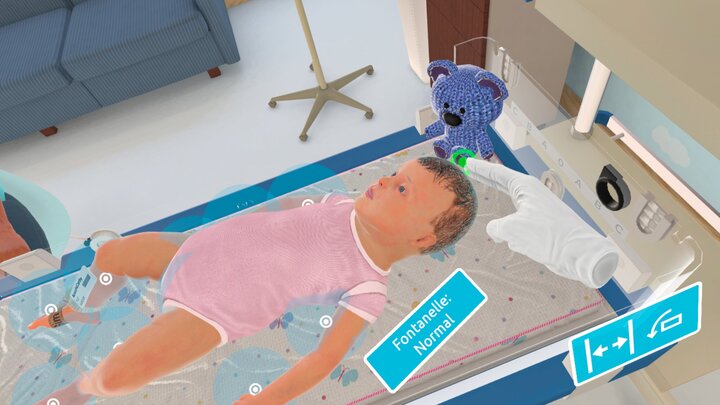1.19: Realism Learners Can Feel, Actionable Insights Educators Can Trust
.jpg)
Table of Contents
Name of the heading
1- Start your table with the syntax {start-table}
2 - Add an H3 Heading to create a new column (this will be the column title)
3 - List cells as bullet points in a List element
4 - End your table with the syntax {end-table}
UbiSim has always delivered clinical simulations that are created for nurses, by nurses, are accurate, curriculum-aligned, and ready to go.
Version 1.19 keeps that promise and raises the bar.
We've added AI-powered narrative analysis that turns data overload into easy insights, two new scenarios you can launch today, and fidelity enhancements that make practice feel even more like the real thing.
Let's walk through what's new.
AI Enhanced Analytics
Here's the reality: simulation platforms generate mountains of data—action logs, quiz responses, timing metrics, decision points. But who has time to dig through it before debriefing? UbiSim now uses AI-powered pattern recognition to automatically analyze learner performance at both individual and cohort levels. The AI surfaces the most frequent critical actions and performance gaps, organized under NCLEX Client Needs categories for clear educational alignment.
For educators, this means instant clarity for debriefing without scrolling through action logs. What used to take 20-30 minutes of data review now takes 2-3 minutes of reading. Aggregated cohort reports reveal curriculum trends, identify consistent skill gaps, and provide quantitative evidence for accreditation. For learners, it means faster, personalized feedback that connects actions to outcomes while the experience is still fresh.
New Clinical Scenarios
Our two new scenarios have hospital-grade realism with zero setup.
Room of Errors
Walk into Mota Perez-Medina's room, and everything is a mess. Over a dozen hazards are hiding in plain sight. Some scream for attention. Others are the kind of quiet mistakes that slip through on a busy shift, the ones that keep nurses up at night.
The call bell is out of reach, the hand sanitizer is expired, and the patient’s home medication bottle is on the bedside table.
Our new Room of Errors scenario trains learners to slow down, scan the environment, and catch errors before they cause harm. It's the kind of situational awareness you can't always count on clinical rotations to teach, packaged into a ready-to-use scenario that reinforces patient safety competencies without hours of custom design work.

Deep Vein Thrombosis
Grace Green's calf is swollen. She's post-op, immobile, and increasingly anxious. Your learner needs to assess risk factors, recognize the signs, communicate with the care team, and make decisions about anticoagulation… fast.
This is the kind of high-risk, high-impact case that separates textbook knowledge from clinical judgment. It's also the kind of case learners might never see during clinicals, or only glimpse once without getting hands-on.
Our new Deep Vein Thrombosis scenario gives them that critical repetition. They practice the full arc of care—assessment, intervention, communication, patient education—in a lifelike environment where mistakes are learning moments, not life-threatening ones. It maps directly to AACN Essentials and Next Generation NCLEX (NGN) competencies, so you can confidently build it into your curriculum.
%20Grace%20Green%20Web%201.png)
Fidelity & Realism Enhancements
These enhancements help learners to bridge theory and practice.
Incisions and Dressings Update
Students may never see consistent wound care opportunities in clinicals. The skill is foundational, but the opportunities are random. And when learners do encounter wounds in practice, they need to be ready, not seeing one for the first time.
Our new Incisions & Dressings editor enhancement gives you control over what used to be left to chance. Configure realistic surgical incisions across multiple body sites. Choose healing states - fresh post-op, progressing normally, or showing signs of infection. Add drainage, select closure methods, apply dressings. Suddenly, you can design the exact wound care experience your curriculum needs, and learners can practice it repeatedly until they're confident.
For you: Build custom post-surgical cases without physical task trainers. Standardize training so every learner gets the same quality practice. Assess their ability to differentiate healthy healing from complications—something that's nearly impossible to control in clinical rotations.
For them: Practice inspection, dressing changes, and clinical judgment in VR where they can repeat, reset, and master the skill before they're standing at a real patient's bedside, wondering if that redness is normal.
Fontanelle Assessment Now Captured
Palpating an infant's fontanelle is one of those quick assessments that tells you so much about hydration status, intracranial pressure, and overall infant health. Your learners have been able to practice this in VR, but now those assessment results are captured in the Facilitator View and included in the Feedback Report.
That means better debriefing. More targeted feedback. And a clearer picture of whether learners are picking up on those subtle clinical cues that separate novice from competent practice.

Platform Improvements
Ghost Teleport: Better Observation, Less VR Dizziness
If you've ever had learners watch a scenario as a ghost observer, there’s sometimes a challenge: they want to see what's happening at the bedside, but the roaming boundaries make it harder to get close without physically walking across your lab space.
Now, ghost participants can teleport to the same spots as active participants, plus new observation points designed for a full-room view. There are no "flying" mechanics (those increase VR dizziness), just intuitive point-to-point teleportation that gives learners the vantage they need without the physical footprint.

The Complete Teaching Loop
Launch → Practice → Analyze → Debrief
Version 1.19 creates a complete, effortless teaching loop:
- Launch clinically accurate scenarios that are curriculum-aligned from day one.
- Practice with enhanced realism that mirrors real clinical environments.
- Analyze performance automatically with AI that surfaces patterns and insights.
- Debrief with clarity and confidence, spending time on reflection instead of data extraction.
Version 1.19 launched December, 2025. As always, reach out if you have questions. We're here to help.
FAQs
Heading 1
Heading 2
Heading 3
Heading 4
Heading 5
Heading 6
Lorem ipsum dolor sit amet, consectetur adipiscing elit, sed do eiusmod tempor incididunt ut labore et dolore magna aliqua. Ut enim ad minim veniam, quis nostrud exercitation ullamco laboris nisi ut aliquip ex ea commodo consequat. Duis aute irure dolor in reprehenderit in voluptate velit esse cillum dolore eu fugiat nulla pariatur.
Block quote
Ordered list
- Item 1
- Item 2
- Item 3
Unordered list
- Item A
- Item B
- Item C
Bold text
Emphasis
Superscript
Subscript
Updating is simple and takes just a few minutes. For the UbiSim Portal, log in and navigate to Admin → Update → Update Now. For headsets, each device must be updated individually. Simply click on the pop-up message when launching the app and select Update Now. Visit our detailed update guide for step-by-step instructions and troubleshooting support.
Yes. Both Grace Green (DVT) and Mota Perez-Medina (Room of Errors) are mapped directly to AACN Essentials and Next Generation NCLEX (NGN) competencies. Room of Errors aligns with Domain 2 (Person-Centered Care), Domain 6 (Interprofessional Partnerships), and Domain 7 (Systems-Based Practice), focusing on patient safety and error prevention. Deep Vein Thrombosis aligns with Domain 1 (Knowledge for Nursing Practice), Domain 4 (Scholarship for Nursing Discipline), and Domain 5 (Quality and Safety), emphasizing clinical judgment and evidence-based interventions.
Absolutely. You can place incisions on multiple body sites (chest, abdomen, hip, laparoscopic sites), select healing states (fresh, acutely healed, scar), choose closure methods (sutures, glue, none), and configure dressing types. You can also add realistic drainage representation (serosanguinous or purulent) to match your learning objectives.
No additional hardware is required. Version 1.19 works on all currently supported Meta Quest headsets (Quest 2, Quest 3, Quest 3S, and Quest Pro). Your facilitator laptop or desktop computer needs to meet basic requirements: Windows/Mac operating system with Chrome browser, 2 GHz dual-core processor, and 4 GB RAM—no software installation required. Simply update your UbiSim app through the headset (via the in-app prompt) and ensure you have a stable internet connection. Each headset updates individually and typically takes 5-10 minutes.
We actively seek input from our community. Reach out to your Customer Success Manager or contact our team directly through your UbiSim account. Your feedback directly shapes our product roadmap.
Explore more
.jpg)
Behind the Scenes: How We Brought Incisions & Dressings to Life in VR
How the UbiSim team built a VR system displaying 300+ distinct incision states—balancing clinical accuracy, technical constraints, and nursing education needs.
.jpg)
Step Inside the Room of Errors: Playful Exploration, Serious Skills
Learn how UbiSim's Room of Errors transforms nurse training through investigative play. Students spot hidden safety risks and build situational awareness.
.jpg)
Why Nursing Simulation Should Start on Day One, Not Later
Don’t treat nursing simulation as a backup. Research shows early VR simulation reduces student stigma by 32%. Here's how to integrate it from day one.




